
15 Mar In the Studio: Five Degrees from True North
Many years ago, when David A Leffel moved into a studio on Union Square in New York City, the walls were white and the landlord refused to let him repaint them. But white studio walls don’t work for artists who paint from life. Reflected light bounces around and true colors, shadows, and any sense of chiaroscuro or mystery are lost. Leffel tried covering the walls with burlap, but the fabric color was too warm. He painted the burlap a dark gray-green, but the paint seeped through onto the walls. So he removed the burlap and just painted the walls. After that, whenever any of his students from the Art Students League took a studio in the building, they repainted their walls. The landlord gave up trying to keep them white.
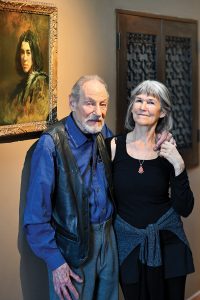
David A Leffel and Sherrie McGraw have been partners in art and life for 45 years.
Today, sitting in his studio at the home he shares with artist Sherrie McGraw, near Taos, New Mexico, Leffel is surrounded by dark gray-green walls in the large, well-organized space. Adjustable shades on 7-foot-tall windows along the north wall allow the right amount of light in, and the wall itself is angled precisely 5 degrees east of north. The room next door, a virtual twin, is McGraw’s studio.
The artists are both internationally acclaimed portrait and still life painters who met 45 years ago when Leffel was McGraw’s teacher at the Art Students League. After many years together in New York, they moved to Taos in 1992. They had side-by-side studios added to the house before they moved in but soon discovered the windows were angled northwest, letting in the late afternoon sun, which forced them to quit painting too early in the day. To the builder, “north was just north,” Leffel says. A few years later, he and McGraw converted those spaces into a living and dining room and had their current — perfect — studios built.
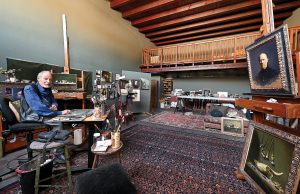
Leffel and McGraw designed their twin studios for optimal lighting, with tall north windows and dark walls that absorb, rather than reflect, light. Leffel’s space contains a long worktable for preparing canvases for both artists, beginning with a roll of stretched raw canvas.
On the walls behind Leffel’s easel are prints of portraits by Rembrandt, Titian, and Velázquez — inspiration from the Old Masters — while much of the high-ceilinged room is open space. A long table is dedicated to preparing canvases, starting with a roll of stretched raw canvas to which the artists apply rabbit skin glue and three coats of white lead paint before cutting and stretching it to the sizes they need. “You can’t buy anything like it,” Leffel says. “As soon as you put the brush on it, you know the difference.”
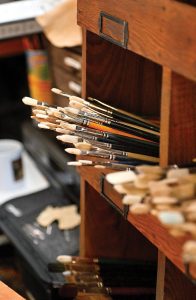
In McGraw’s studio, an antique wooden cabinet has open cubbies for painting supplies.
In McGraw’s studio, long shelves overflow with bundles and vases of dried flowers and plants from the extensive gardens around their home. Chinese Tang Dynasty horse sculptures, also used in still life arrangements, sit high on another shelf, and large panels are covered with drawings from the weekly life drawing classes McGraw leads. “She’s an accumulator, and I’m a thrower-outer,” Leffel says with a smile. “But she’s very organized.”
Leffel and McGraw clearly have enormous admiration for each other as artists, as well as joy and delight as life partners. “David is really my favorite artist in art history,” McGraw says, to which Leffel immediately replies, “Which I could never understand. I kept trying to push her toward Rembrandt.”
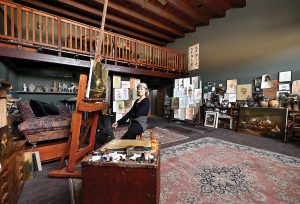
Long shelves on one side of McGraw’s space hold dried flowers and plants from the couple’s gardens, along with ceramic vessels and other objects she enjoys painting. On the back wall under a storage loft are Chinese Tang Dynasty horse sculptures, also used in still life arrangements.
In the classroom at the Art Students League, Leffel remembers being impressed not only by McGraw’s painting skills but by the composition of her still life arrangements. “Most students, if you ask them to set up a still life, it’s just a bunch of stuff,” he says. With McGraw, he knew she had an intuitive sense of the relationship between objects and of the size and placement of the figure in portraiture.
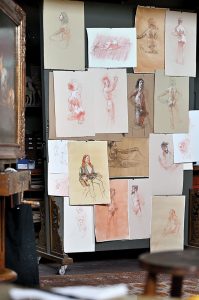
A vertical board displays sketches from the weekly life drawing classes McGraw hosts.
For her part, McGraw appreciated that Leffel never offered second-hand painting tips but always taught from his own understanding. His approach generated a radical and lasting shift in how she perceived the act of painting, which she and Leffel have used as teachers for many years. Leffel, now 91, continues to share his long-held belief that by starting with an intention rather than technique, every artist develops their own process and style.
“It became apparent to me over the years: You paint to learn, and in painting to learn, you learn to paint,” he says. “You discover how fulfilling the act of painting is.” He recalls once during a live demonstration when he was simply painting the background for a still life. “It was just a flat background, but in my head I was thinking: This is the best. The way the paint felt coming off the brush on the canvas, that was enough for me.”
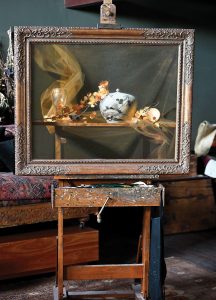
McGraw’s Aspen Leaves (oil on canvas, 30 by 38 inches) was part of her 2016 retrospective at the Butler Institute of American Art in Youngstown, Ohio.
For the past three years, McGraw has planned, directed, filmed, and produced weekly live-stream classes featuring Leffel and sometimes guest artists in his studio at brightlightfineart.com. Often, she films him painting and then presents the video online, soliciting questions from viewers for Leffel to answer live. With artists tuning in from around the world, he says, “It’s fun, talking about painting and life, psychology, whatever comes up.”
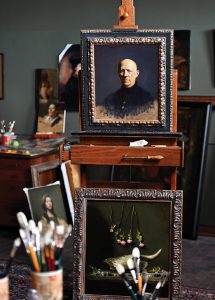
Man With a Pendant (oil on canvas, 19 by 16 inches), by Leffel, was an “intriguing challenge to capture presence with paint,” he says.
In their studios, the two artists are also busy preparing for upcoming shows. McGraw and Leffel will both participate in the Oil Painters of America National Exhibition & Convention, March 31 through April 30 at the Reinert Fine Art Gallery in Charleston, South Carolina, and at the Prix de West Invitational Art Exhibition & Sale at the National Cowboy & Western Heritage Museum, opening June 2. They will also be featured in a two-artist show at the Taos Art Museum at Fechin House, September 5 through October 15.

Leffel works on a still life featuring a clay vessel flanked by tiny Chinese bird feeders made for caged birds. The arrangement is visible to the left of the painting. Leffel says he would stay in his studio and paint without even stopping to eat if he could.
Living with another artist has the added benefit of knowing that the other person understands the importance of studio time, McGraw says. Unless absolutely necessary, she and Leffel never interrupt each other while painting. They also learned early on not to offer unsolicited comments on the other’s work. “About 35 years ago, I would critique her paintings, and she got angry. Because she was so good, I didn’t understand why she didn’t see what I thought she should see,” Leffel says. What they eventually realized is that each artist has a distinctive vision and approach, even if they’re painting the same subject. “You’re not trying to get the other person to paint the picture you would paint,” Leffel says. “So, it’s very tricky not to tell them, ‘Do this because that’s the way I would paint it.’”
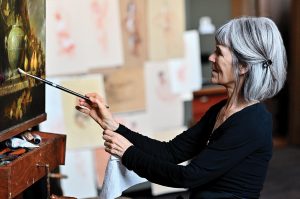
McGraw works on a still life piece, using her left hand to steady her painting hand. When she was 30, she also began teaching at the Art Students League and has led private classes and workshops around the country. She and Leffel began teaching together in the mid-1980s. Today they offer weekly online classes featuring Leffel and sometimes guest artists in his studio.
Still, they find themselves gratefully accepting occasional suggestions that turn out to be just right. Once Leffel was painting a still life with a Zia Pueblo pottery vessel containing a dried plant whose stems and leaves cascaded out. “There was a certain design in the leaves that he didn’t see,” McGraw says. “I pointed it out, and he said, ‘Ah!’ And that changed the piece.” Leffel smiles and nods, remembering. “She’s the only one I would trust to ask,” he says. Likewise, McGraw recalls feeling frustrated when a painting that had been flowing beautifully at first seemed to stall the next day. Leffel quietly told her, “You’ve got a tiger by the tail,” and McGraw remembered her initial inspiration for the piece. Returning to that feeling, she produced a painting with which she was especially pleased.
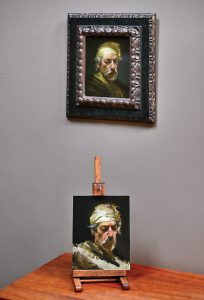
An oil study for Leffel’s Self Portrait with White Headwrap (oil on board, 9 by 7 inches) sits on a table beneath the finished painting.
“One of the qualities that attracted me from the very outset of our relationship is that she had an innocent, open quality that she’s never lost,” Leffel says. Looking at him, McGraw replies, “I can say the same about you — the innocence of a child.”
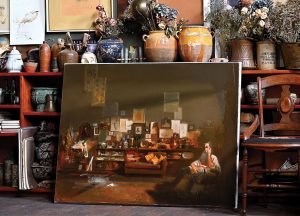
McGraw’s The Inspiration Wall (oil on canvas, 39 by 50 inches) leans against her real-life inspiration wall, where drawings, vases, dried flowers, and other objects wait to become part of her still life arrangements.
Outside their studios, the artists spend almost all their time together. They enjoy traveling, teaching, and talking about art. During the summer, they often eat lunch together in the garden. But aside from lunch, their workdays rarely contain breaks. “We try never to stop early for food,” McGraw says. “If we could manage it, we would do without lunch.” Leffel nods in agreement. “These are the best studios we’ve ever had; they have the best light. I would like to never leave the studio.”






No Comments